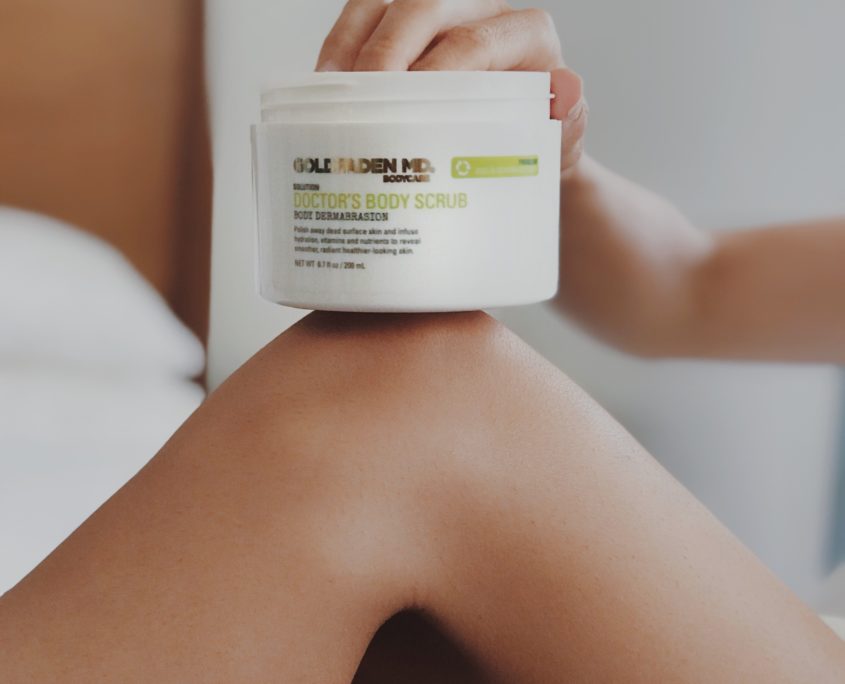
After 50 years of practicing Dermatology and treating diseases of the skin, Dr. Goldfaden has seen the full spectrum of skin conditions. “The skin on your body is as important as the skin on your face.” Choosing clean body products can target and correct the most common body issue most people are dealing with. Dr. G created our NEW Body Collection to extend healthy skin care from the chest down. Our Doctor’s Body Scrub is a multi-active scrub features micro-fine exfoliating crystals, skin-softening Bamboo Extract, skin-brightening Fruit Enzymes, soothing Probiotic-fermented Extract, and antioxidant-rich Red Algae. After exfoliating, Firm Believer Body Serum offers elasticity enhancing Radish Root Extract and skin softening Marula Oil and Shea Butter. Hyaluronic Acid helps to hydrate and plump skin while a combination of Brown + Red Algae along with Coffee & Gotu Kola Extracts work to increase microcirculation while helping to firm and tone the skin.
We asked Dr. G to weigh in on common body skin conditions (and some you may not have heard of) and how exfoliation is still the most important and effective part of your skincare regimen. Of course if you think you may be suffering from any of the below, you should see your dermatologist for a formal diagnosis, but in the meantime taking time to care and treat your body at home will not only make your skin glow but also make you feel good.
Keratosis Pilaris
What is it: A very common especially in females and children. Keratosis Pilaris is caused by a buildup of keratin, excess skin and oil which blocks the hair follicle causing little bumps (often white) under the skin’s surface. Found on the arms and thighs. Very commonly this is an inherited condition and people may refer to it as ‘chicken skin’.
How to help: Exfoliation won’t cure Keratosis Pilaris but it can help the roughness of the skin and the appearance of the bumps. Physical exfoliants (like a scrub) can assist in smoother, more even-textured skin, while a chemical exfoliant such as Lactic, Glycolic or fruit acids can work in tandem to smooth skin out. Hydrating the skin is also very important when treating Keratosis Pilaris.
Xerosis
What is it: The medical term for ‘excess dry skin’, Xerosis is caused by lack of moisture in the skin. This can be caused by dry climates, cold weather, artificial heating and aging.
How to help: Regular exfoliation of the body will remove dead, dry skin allowing active hydrating ingredients to treat the skin. Systemic hydration (drinking water, eating foods high with a high-water content and topical hydration (serums, moisturizers, lotions and creams) are crucial to reverse and treat Xerosis.
Ichthyosis
What is it: An inherited condition, which can vary in severity. Most commonly found on the legs, however, can be all over the body in more severe cases. Ichthyosis coming from the Greek word for ‘fish’ appears as dry, thickened, scaly skin.
How to help: Exfoliation will help this condition by removing dry, scaly skin. Use of a very hydrating body lotion or cream is preferred.
Teania Versicolor
What is it: Meaning ‘fungus of many colors’, Tinea Versicolor appears as white patchy, flat splotches usually found on the upper arms and face. More noticeable when the skin gets sun or tanned.
How to help: Exfoliation is excellent for the removal of the superficial fungus and dead skin.
Backne, Chest Breakouts and Butt Bumps
What are they: Little or big bumps/pimples that show up on the back, the chest and the butt. All are considered acne and can be caused by hormones, clothing friction, cosmetic products/SPF that are too heavy or bacteria left behind from sweat and dirt. The overproduction of oil causes hair follicles to get clogged causing inflammation which is the pimple or bump that surfaces. You’re more prone to getting pimples and breakouts on your back vs. the face in general because those areas have high concentrations of hair follicles and sebaceous glands (glands that secrete an oily matter called sebum) which when clogged, cause breakouts. The skin located on the back is also very think and endures a different environment altogether. The back area is typically clothed, so the skin can’t breathe as easily and experiences conditions such as; sweat build-up, wearing tight and restrictive clothing when exercising and not showering after. This can lead to clogged hair follicles, over oil production, and acne.
How to help: Always shower after working out or sweating. Try and not sit around in damp workout clothing. Regular exfoliation unplugs clogged pores and allows for the release of natural skin oils. Regular exfoliation also helps to maintain open pores, decreases pore size, minimizes many types of superficial scarring and ward off bacteria which causes breakouts and rashes. Try switching to a lightweight body serum or oil-free lotion for the warmer months.


 It’s challenging to definitively pin down exactly how much of specific products—and which products at that—can absorb into your bloodstream and thus pose potential risks.
It’s challenging to definitively pin down exactly how much of specific products—and which products at that—can absorb into your bloodstream and thus pose potential risks.